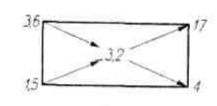In a cheese dairy, we often deal with a mixture of milk with different fat content. Therefore, the easiest way to calculate the mixture is with the help given in fig.
 figury (the so-called. Pearson square - read Pirson).
figury (the so-called. Pearson square - read Pirson).
Task: We have milk that is fat content 1,5% mix with whole milk 3,6% fat, so as to obtain mixed milk with the content of 3,2%.
Execution: the lowest is entered at the bottom left %, highest at the top, medium and in the middle. Along the diagonal there are differences. We free numbers from the decimal point. In this case, we get a number on the top right 17, downstairs 4. These are proportional values, which point out to each 17 l of whole milk you need to take 4 l of standing milk, to obtain a medium fat milk mixture 3,2%.
If we want to have such a mixture in the boiler 420 l, we are still carrying out the account, as follows;
420 : 21 = 20, therefore whole milk 17 · 20 = 340 l, and milk from standing still 4 • 20 = 80 l.
Ratio of the fat content of the cheese milk to the fat content of the dry matter of the processed cheese
Contents |
Fat content in cheese milk |
||
fat in the dry matter of cheeses % |
Hard cheeses of Emmental type |
Hard Dutch type edam cheeses, Gouda, lechickie, Trappists, tylżyckie cheddar |
Camembrt and Limburgish soft cheeses |
5 - skinny |
0,25 | 0,25 | 0,20 |
10 - ¼-greasy |
0,55 | 0,50 | 0,45 |
| 15 – | 0,75 | 0,70 | 0,65 |
20 —½-oily |
1,00 | 0,95 | 0,85 |
| 25 – | 1,40 | 1,30 | 1,10 |
30 —¾-oily |
1,80 | 1,70 | 1,50 |
| 35 – | 2,20 | 2,10 | 1,90 |
40 - fat45 —Full fat50 - cream |
2,60
3,15 3,70 |
2,50
3,05 3,60 |
2,30
2,85 3,40 |
To be sure, it is possible in practice to always have a slightly higher percentage of milk fat than the calculated figure. This allowance is 0,1 do 0,2%. This is due to the more or less different treatment of the milk in the boiler, resulting in a variable fat residue in the whey
